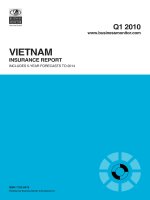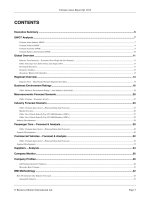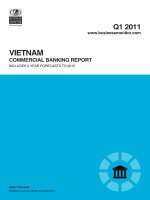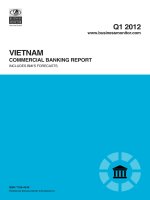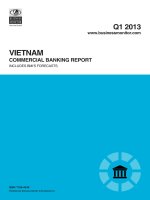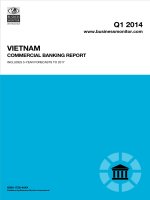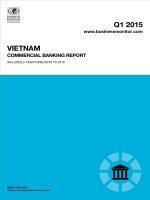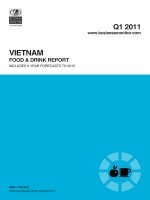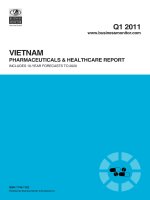Vietnam infrastructure report q1 2016
Bạn đang xem bản rút gọn của tài liệu. Xem và tải ngay bản đầy đủ của tài liệu tại đây (425.43 KB, 83 trang )
Q1 2016
www.bmiresearch.com
VIETNAM
INFRASTRUCTURE REPORT
INCLUDES 10-YEAR FORECASTS TO 2024
Published by:BMI Research
Vietnam Infrastructure Report Q1 2016
INCLUDES 10-YEAR FORECASTS TO 2024
Part of BMI’s Industry Report & Forecasts Series
Published by: BMI Research
Copy deadline: October 2015
ISSN: 1750-5593
BMI Research
Senator House
85 Queen Victoria Street
London
EC4V 4AB
United Kingdom
Tel: +44 (0) 20 7248 0468
Fax: +44 (0) 20 7248 0467
Email:
Web:
© 2015 Business Monitor International Ltd
All rights reserved.
All information contained in this publication is
copyrighted in the name of Business Monitor
International Ltd, and as such no part of this
publication may be reproduced, repackaged,
redistributed, resold in whole or in any part, or used
in any form or by any means graphic, electronic or
mechanical, including photocopying, recording,
taping, or by information storage or retrieval, or by
any other means, without the express written consent
of the publisher.
DISCLAIMER
All information contained in this publication has been researched and compiled from sources believed to be accurate and reliable at the time of
publishing. However, in view of the natural scope for human and/or mechanical error, either at source or during production, Business Monitor
International Ltd accepts no liability whatsoever for any loss or damage resulting from errors, inaccuracies or omissions affecting any part of the
publication. All information is provided without warranty, and Business Monitor International Ltd makes no representation of warranty of any kind
as to the accuracy or completeness of any information hereto contained.
Vietnam Infrastructure Report Q1 2016
INCLUDES 10-YEAR FORECASTS TO 2024
Part of BMI’s Industry Report & Forecasts Series
Published by: BMI Research
Copy deadline: October 2015
ISSN: 1750-5593
BMI Research
Senator House
85 Queen Victoria Street
London
EC4V 4AB
United Kingdom
Tel: +44 (0) 20 7248 0468
Fax: +44 (0) 20 7248 0467
Email:
Web:
© 2015 Business Monitor International Ltd
All rights reserved.
All information contained in this publication is
copyrighted in the name of Business Monitor
International Ltd, and as such no part of this
publication may be reproduced, repackaged,
redistributed, resold in whole or in any part, or used
in any form or by any means graphic, electronic or
mechanical, including photocopying, recording,
taping, or by information storage or retrieval, or by
any other means, without the express written consent
of the publisher.
DISCLAIMER
All information contained in this publication has been researched and compiled from sources believed to be accurate and reliable at the time of
publishing. However, in view of the natural scope for human and/or mechanical error, either at source or during production, Business Monitor
International Ltd accepts no liability whatsoever for any loss or damage resulting from errors, inaccuracies or omissions affecting any part of the
publication. All information is provided without warranty, and Business Monitor International Ltd makes no representation of warranty of any kind
as to the accuracy or completeness of any information hereto contained.
Vietnam Infrastructure Report Q1 2016
CONTENTS
BMI Industry View ............................................................................................................... 7
Table: Infrastructure - Construction Industry Forecasts (Vietnam 2014-2020) . . . . . . . . . . . . . . . . . . . . . . . . . . . . . . . . . . . . . . . . . . . . . . . . . . . . . . . . . . . . . . . . . . . . . . . . 7
Table: Infrastructure Risk Reward Index (Vietnam 2015-2015) . . . . . . . . . . . . . . . . . . . . . . . . . . . . . . . . . . . . . . . . . . . . . . . . . . . . . . . . . . . . . . . . . . . . . . . . . . . . . . . . . . . . . . . . 8
SWOT .................................................................................................................................... 9
Infrastructure SWOT .................................................................................................................................. 9
Industry Forecast .............................................................................................................. 11
Construction And Infrastructure Forecast Scenario ........................................................................................ 11
Latest Updates ....................................................................................................................................... 11
Table: Construction And Infrastructure Industry Data (Vietnam 2014-2024) . . . . . . . . . . . . . . . . . . . . . . . . . . . . . . . . . . . . . . . . . . . . . . . . . . . . . . . . . . . . . . . . . . . . . . . . . 11
Table: Construction And Infrastructure Industry Data (Vietnam 2019-2024) . . . . . . . . . . . . . . . . . . . . . . . . . . . . . . . . . . . . . . . . . . . . . . . . . . . . . . . . . . . . . . . . . . . . . . . . . 12
Transport Infrastructure - Outlook And Overview .......................................................................................... 21
Latest Updates ....................................................................................................................................... 21
Table: Transport Infrastructure Industry Data (Vietnam 2014-2024) . . . . . . . . . . . . . . . . . . . . . . . . . . . . . . . . . . . . . . . . . . . . . . . . . . . . . . . . . . . . . . . . . . . . . . . . . . . . . . . . . 21
Table: Competitiveness Of Vietnam's Infrastructure . . . . . . . . . . . . . . . . . . . . . . . . . . . . . . . . . . . . . . . . . . . . . . . . . . . . . . . . . . . . . . . . . . . . . . . . . . . . . . . . . . . . . . . . . . . . . . . . . . . 22
Table: Transport Projects . . . . . . . . . . . . . . . . . . . . . . . . . . . . . . . . . . . . . . . . . . . . . . . . . . . . . . . . . . . . . . . . . . . . . . . . . . . . . . . . . . . . . . . . . . . . . . . . . . . . . . . . . . . . . . . . . . . . . . . . . . . . . . 35
Energy And Utilities Infrastructure - Outlook And Overview ............................................................................ 36
Latest Updates ....................................................................................................................................... 36
Table: Energy And Utilities Infrastructure Data (Vietnam 2014-2024) . . . . . . . . . . . . . . . . . . . . . . . . . . . . . . . . . . . . . . . . . . . . . . . . . . . . . . . . . . . . . . . . . . . . . . . . . . . . . . . . 36
Table: Construction & Social Infrastructure Projects . . . . . . . . . . . . . . . . . . . . . . . . . . . . . . . . . . . . . . . . . . . . . . . . . . . . . . . . . . . . . . . . . . . . . . . . . . . . . . . . . . . . . . . . . . . . . . . . . . 50
Residential/Non-Residential Building - Outlook And Overview ......................................................................... 51
Latest Updates ....................................................................................................................................... 51
Table: Residential and Non-Residential Building Industry Data (Vietnam 2014-2024) . . . . . . . . . . . . . . . . . . . . . . . . . . . . . . . . . . . . . . . . . . . . . . . . . . . . . . . . . . . . . . . 51
Table: Construction & Social Infrastructure . . . . . . . . . . . . . . . . . . . . . . . . . . . . . . . . . . . . . . . . . . . . . . . . . . . . . . . . . . . . . . . . . . . . . . . . . . . . . . . . . . . . . . . . . . . . . . . . . . . . . . . . . . . 55
Industry Risk Reward Ratings .......................................................................................... 56
Vietnam - Infrastructure Risk/Reward Index .................................................................................................
Vietnam Risk/Reward Index .....................................................................................................................
Rewards ..............................................................................................................................................
Risks ..................................................................................................................................................
Asia Pacific Infrastructure RRI: Developed Markets Increasingly At Risk ...........................................................
56
56
56
57
59
Table: Asia Risk/Reward Index . . . . . . . . . . . . . . . . . . . . . . . . . . . . . . . . . . . . . . . . . . . . . . . . . . . . . . . . . . . . . . . . . . . . . . . . . . . . . . . . . . . . . . . . . . . . . . . . . . . . . . . . . . . . . . . . . . . . . . . . . 65
Market Overview ............................................................................................................... 66
Competitive Landscape ............................................................................................................................. 66
Table: Vietnam EQS Data . . . . . . . . . . . . . . . . . . . . . . . . . . . . . . . . . . . . . . . . . . . . . . . . . . . . . . . . . . . . . . . . . . . . . . . . . . . . . . . . . . . . . . . . . . . . . . . . . . . . . . . . . . . . . . . . . . . . . . . . . . . . . . 66
Company Profile ................................................................................................................ 67
Cavico Corporation ................................................................................................................................. 67
Electricity Vietnam Group ......................................................................................................................... 70
Methodology ...................................................................................................................... 75
© Business Monitor International Ltd
Page 4
Vietnam Infrastructure Report Q1 2016
Industry Forecast Methodology ................................................................................................................
Sector-Specific Methodology ....................................................................................................................
Risk/Reward Index Methodology ...............................................................................................................
Sector-Specific Methodology ....................................................................................................................
75
76
80
81
Table: Infrastructure Risk/Reward Index Indicators . . . . . . . . . . . . . . . . . . . . . . . . . . . . . . . . . . . . . . . . . . . . . . . . . . . . . . . . . . . . . . . . . . . . . . . . . . . . . . . . . . . . . . . . . . . . . . . . . . . 81
Table: Weighting Of Indicators . . . . . . . . . . . . . . . . . . . . . . . . . . . . . . . . . . . . . . . . . . . . . . . . . . . . . . . . . . . . . . . . . . . . . . . . . . . . . . . . . . . . . . . . . . . . . . . . . . . . . . . . . . . . . . . . . . . . . . . . . 82
© Business Monitor International Ltd
Page 5
Vietnam Infrastructure Report Q1 2016
BMI Industry View
BMI View: A recovery in Vietnam's property market, coupled with positive regulatory changes, robust
economic growth and favourable funding conditions will help to spur construction activity over the coming
quarters, with the transport sector expected to outperform. Growth remains below potential as ongoing
reforms of state-owned enterprises will require years of implementation before any significant impact is
seen.
Forecast And Latest Updates
■
We maintain a positive outlook for Vietnam's construction sector and expect real growth of 5.9% in 2015
and to average 6.1% per annum between 2015-2019.
■
An expected recovery in the real estate market supported by easing foreign restrictions on property
ownership, resilience in exports as well as a growing tourism sector will support growth for the
residential and non-residential building segment.
■
Growth will still not be at full potential, largely owing to the long implementation period required before
reforms can have a significant impact on the sector.
Table: Infrastructure - Construction Industry Forecasts (Vietnam 2014-2020)
2014
2015f
2016f
2017f
2018f
2019f
2020f
209,875.00
224,728.26
246,868.47
274,344.62
304,400.31
337,481.12
374,049.66
Construction Industry
Value, Real Growth, %
y-o-y
7.10
4.98
6.15
6.23
6.06
6.07
6.04
Construction Industry
Value, % of GDP
5.3
5.3
5.2
5.2
5.2
5.1
5.1
Construction industry
value, VNDbn
f = BMI forecast. Source: Vietnam General Statistics Office, BMI
Risk/Reward Index
■
Vietnam's Risk/Reward score remains the same at 54.2, despite dropping one position to 13th place spot,
as growth in Thailand over the past quarter saw the latter move up to 11th place.
■
A brightening economic outlook indicates that risks to our outlook for the country remain on the upside
over the coming quarters.
■
Positive policy formation in terms of public private partnership regulations, investment laws and foreign
ownership restrictions on property also support our increasingly positive outlook.
© Business Monitor International Ltd
Page 7
Vietnam Infrastructure Report Q1 2016
Table: Infrastructure Risk Reward Index (Vietnam 2015-2015)
Geography
Vietnam
Risk/Reward
Index
Rewards
Industry
Rewards
Country
Rewards
Risks
Industry
Risks
Country
Risks
54
55
52
60
51
40
59
Source: BMI
© Business Monitor International Ltd
Page 8
Vietnam Infrastructure Report Q1 2016
SWOT
Infrastructure SWOT
Vietnam Infrastructure Industry SWOT
Strengths
■
The country's strong project pipeline will sustain growth in the sector and add
capabilities for further development, particularly as transport structure improves.
■
Rapid growth and firm government commitment has attracted investment from many
of the world's largest infrastructure companies.
■
The poor state of infrastructure in the country provides plenty of opportunities for
foreign investors and construction companies.
Weaknesses
■
A hike in electricity prices should stimulate investment in the energy sector.
■
State-owned companies dominate the infrastructure market. This is especially the
case in the utilities sector, where Electricity of Vietnam's dominant position has
deterred investors.
■
Vietnam relies heavily on foreign imports and it is estimated the country requires 2mn
tonnes of steel billets to be imported a year.
■
The country offers a risky environment for major infrastructure projects, especially in
relation to project finance operations.
■
Power outages are occurring daily in Vietnam, highlighting the country's severe
electricity problems.
Opportunities
■
Demand for urban infrastructure projects in transport and sanitation over our 10-year
forecast period to 2023 will rise, in tandem with urbanisation.
■
Severe drought is driving demand in electricity generation sources besides
hydropower, such as gas-fired and wind-powered plants.
■
If the government's attempts to cool the overheating economy are successful,
Vietnam will see a more stable growth trajectory over the long term.
© Business Monitor International Ltd
Page 9
Vietnam Infrastructure Report Q1 2016
Vietnam Infrastructure Industry SWOT - Continued
■
Greater opportunities for public-private partnerships (PPP) - the country is offering the
Dau Giay-Phan Thiet expressway project, the first road project and the largest
infrastructure project to be developed under a PPP format.
■
Efforts to implement reforms will help improve the countrys' business environment,
attracting greater foreign direct investment.
Threats
■
A possible shift in the Vietnamese government's focus - from driving economic
growth towards fighting inflation and addressing macroeconomic imbalances - could
have a cooling effect on the sector.
■
Without foreign capital, public spending cuts and tighter credit conditions are likely to
keep economic activity depressed.
■
Lack of energy infrastructure holds downside risk to nearly all projects and presents a
significant bottleneck to development.
■
Should any significant events occur to highlight Vietnam's structural difficulties,
uncertainty and downside risks in the business environment could have a negative
impact going forward.
■
The EU predicts Vietnam will not become a true market economy until 2018, and even
this forecast is somewhat ambitious.
© Business Monitor International Ltd
Page 10
Vietnam Infrastructure Report Q1 2016
Industry Forecast
Construction And Infrastructure Forecast Scenario
BMI View: A recovery in Vietnam's property market, coupled with positive regulatory changes, robust
economic growth and favourable funding conditions will help to spur construction activity over the coming
quarters, with the transport sector expected to outperform. Growth remains below potential as ongoing
reforms of state-owned enterprises will require years of implementation before any significant impact is
seen.
Latest Updates
■
The residential building segment is on track for a recovery, with strong growth in demand over H115.
Easing of foreign ownership restrictions will also help to spur demand, in turn boosting construction
activity.
■
The country's exports remain resilient, and a robust economic outlook will help support non-residential
construction.
■
Transport infrastructure remains a focus, and Metro Pacific Investment Corporation's recent investment
into the country highlights potential in the road construction segment.
Table: Construction And Infrastructure Industry Data (Vietnam 2014-2024)
2014e
2015f
2016f
2017f
2018f
2019f
2020f
2021f
2022f
2023f
2024f
Construction
industry value, 209,875 224,728 246,868 274,345 304,400 337,481 374,050 414,133 458,444 506,937 560,011
VNDbn
Construction
Industry Value,
Real Growth,
% y-o-y
7
5
6
6
6
6
6
6
6
6
6
Construction
Industry Value,
% of GDP
5
5
5
5
5
5
5
5
5
5
5
Infrastructure
industry value,
VNDbn
62,975
67,801
74,755
82,796
90,428
Infrastructure
industry value
real growth, %
y-o-y
8
6
7
6
4
98,650 107,565 117,265 127,830 139,407 151,991
4
4
4
4
5
4
Vietnam General Statistics Office
© Business Monitor International Ltd
Page 11
Vietnam Infrastructure Report Q1 2016
Table: Construction And Infrastructure Industry Data (Vietnam 2019-2024)
2019f
2020f
2021f
2022f
2023f
2024f
Construction
industry value,
VNDbn
337,481.12
374,049.66
414,132.59
458,443.76
506,936.63
560,010.92
Construction
industry value,
USDbn
16.2
18.1
20.3
22.6
25.3
28.2
Construction
Industry Value,
Real Growth,
% y-o-y
6.07
6.04
6.02
6.00
5.98
5.87
Construction
Industry Value,
% of GDP
5.1
5.1
5.1
5.1
5.1
5.1
Fixed capital
formation,
VNDbn
1,855,370.43
2,074,704.90
2,317,754.51
2,586,850.44
2,881,725.52
3,210,213.41
Fixed capital
formation,
USDbn
82.46
93.04
104.88
118.12
132.80
149.31
Fixed capital
formation, % of
GDP
28.26
28.41
28.57
28.73
28.88
29.03
923.14
1,035.16
1,160.29
1,300.02
1,454.56
1,628.21
7.00
6.70
6.70
6.60
6.50
6.50
Construction
sector
employment,
'000
5,168.5
5,529.6
5,911.3
6,314.9
6,741.1
7,184.6
Construction
industry
employment,
% y-o-y
7.09
6.99
6.90
6.83
6.75
6.58
68,011.07
68,401.62
68,772.11
69,122.44
69,448.57
69,743.20
Construction
industry
employees as
% of total
labour force
7.60
8.08
8.60
9.14
9.71
10.30
Infrastructure
industry value,
% of total
construction
29.2
28.8
28.3
27.9
27.5
27.1
Fixed capital
formation per
capita, USD
Real capital
formation
growth, % y-oy
Active
population,
total, '000
© Business Monitor International Ltd
Page 12
Vietnam Infrastructure Report Q1 2016
Construction And Infrastructure Industry Data (Vietnam 2019-2024) - Continued
2019f
2020f
2021f
2022f
2023f
2024f
Infrastructure
industry value,
VNDbn
98,650.18
107,564.59
117,264.62
127,830.17
139,406.71
151,991.11
Infrastructure
industry value,
USDbn
4.73
5.21
5.73
6.31
6.95
7.66
Infrastructure
industry value
real growth, %
y-o-y
4.3
4.2
4.3
4.3
4.5
4.4
Infrastructure
industry value,
% of GDP
1.5
1.5
1.4
1.4
1.4
1.4
Residential and
Non-residential
Building
Industry Value
As % of Total
Construction
70.77
71.24
71.68
72.12
72.50
72.86
Residential and
Non-residential
Building
Industry Value,
VNDbn
238,830.94
266,485.07
296,867.97
330,613.59
367,529.92
408,019.81
Residential and
Non-residential
Building
Industry Value,
USDbn
11.45
12.90
14.52
16.33
18.33
20.56
Residential and
Non-residential
Building
Industry Value
Real Growth
(%)
6.82
6.78
6.70
6.67
6.57
6.42
Residential and
Non-residential
Building
Industry Value
as % of GDP
3.64
3.65
3.66
3.67
3.68
3.69
Cement
production
(including
imported
clinker), tonnes
77,698,611
80,631,004
-709,415 -54,282,095,664
1,084,967,341
25,354,357,429,702
Cement
production
(including
imported
clinker),
tonnes, % y-oy
4.0
3.8
7,651,566.7
-102.0
2,336,777.5
68,349,455
71,281,848
-10,058,571 -54,291,444,820
1,075,618,185
25,354,348,080,546
Cement
consumption,
tonnes
© Business Monitor International Ltd
-100.9
Page 13
Vietnam Infrastructure Report Q1 2016
Construction And Infrastructure Industry Data (Vietnam 2019-2024) - Continued
2019f
2020f
2021f
2022f
2023f
2024f
Cement
consumption,
tonnes, % y-oy
4.5
4.3
-114.1
539,653.0
-102.0
2,357,088.5
Cement net
exports, tonnes
9,349,156
9,349,156
9,349,156
9,349,156
9,349,156
9,349,156
Cement net
exports,
tonnes, % y-oy
0.0
0.0
0.0
0.0
0.0
0.0
f = BMI forecast. Source: National sources, BMI
The outlook for Vietnam's construction sector is gradually improving, underpinned by a recovery in the
residential market, positive regulatory changes, robust economic growth and favourable funding conditions.
We forecast the sector to grow by 5.0% and 6.2% in 2015 and 2016 in real terms respectively. We expect
real growth to average 6.1% between 2017 and 2019, which represents an increase from the 4.8% annual
average growth rate registered over the period 2010-2014.
© Business Monitor International Ltd
Page 14
Vietnam Infrastructure Report Q1 2016
Stronger Quarters Ahead
Vietnam - Construction Industry Value, VNDbn
400,000
8
300,000
7
200,000
6
100,000
5
0
4
2013
2014
2015f
2016f
2017f
2018f
2019f
Construction industry value, VNDbn (LHS)
Construction Industry Value, Real Growth, % y-o-y (RHS)
e/f = BMI estimate/forecast. Source: Vietnam General Statistics Office, BMI
According to the Vietnam General Statistics Office, the construction sector expanded by 4.9% y-o-y in
Q315, bringing growth for the first three quarters of 2015 to 4.2% y-o-y. While growth over the first nine
months of 2015 is still below our full year forecast, we expect construction activity to accelerate over the
coming quarter and beyond.
© Business Monitor International Ltd
Page 15
Vietnam Infrastructure Report Q1 2016
Growth Gaining Traction
Vietnam - Construction Industry Value, VNDbn (LHS); % chg y-o-y (RHS)
Source: Vietnam General Statistics Office, BMI
Property Sector Poised For Recovery
A key factor supporting growth over the coming quarters is an improving residential property market
outlook, with demand being propped up by foreign buyers. While the residential market has seen subdued
growth over the past years since its property market bubble burst four years ago, favourable policies are
expected to help spur a recovery in the market. As of July 1 2015, foreigners are able to purchase property
in the country based on the amended Law on Residential Housing (LRH) which was approved by the
government in November 2014. Under the amended LRH, foreigners granted visas to Vietnam are allowed
to buy residential properties for a 50-year leasehold tenure, with possibility of renewal. In addition,
properties owned by foreigners can now be sub-leased, inherited and collateralised, whereas they were
previously limited to occupancy purposes only.
Other factors will also help to support demand for housing, including a growing middle income class as
well as Vietnamese living overseas returning to the country. Property sales data attest to a strengthening of
the sector, and for the period H115, both Hanoi and Ho Chi Minh City recorded 9,250 and 8,750
© Business Monitor International Ltd
Page 16
Vietnam Infrastructure Report Q1 2016
transactions respectively, representing a doubling of sales over the same period last year, according to
Thanh Nien News.
Beyond the residential building segment, other factors that we highlighted previously will continue to
support the broader construction sector over the coming quarters.
Improving Regulatory Environment: We highlight improvements in the country's regulatory environment
which will help to boost foreign direct investment (FDI), following the issuance of the government decree
(15/2015/ND-CP) regarding public-private-partnerships (PPPs) and the 2014 Investment Law (see 'New
Decree To Boost Infrastructure Investment Climate', March 5 and 'Investment Law To Lift Business
Environment', June 16). The Vietnamese government is also implementing several structural reforms
including restructuring and privatising SOEs, raising electricity prices, as well as widening and streamlining
the tax base. These changes will contribute to a gradual improvement in the country's business environment,
boosting construction activity.
FDI Returns
Vietnam - Foreign Direct Investment, USDmn (LHS) And % chg y-o-y (RHS)
Source: World Bank, BMI
© Business Monitor International Ltd
Page 17
Vietnam Infrastructure Report Q1 2016
Conducive Monetary Conditions: Meanwhile, easing monetary conditions will help lower the cost of
capital for construction companies and ease liquidity within the country, boosting construction activity. Our
Country Risk (CR) team believes that benign inflation will allow the Vietnamese central bank ample room
to cut rates, and expect the State Bank of Vietnam to lower its refinancing rate by 50 basis points (bps) to
6.00% (see 'Benign Inflation To Allow For Lower Interest Rates', July 29 2015). Although we acknowledge
that the banking sector remains burdened by bad debts, ongoing banking reform efforts by the government
should gradually strengthen the local banks. Construction input costs are also on a downtrend.
Room For Easing
Vietnam - Policy Rate, %; CPI For Housing And Construction Material, % chg y-o-y
Source: Vietnam General Statistics Office, State Bank of Vietnam, BMI
Improving Economic Environment: Vietnam's robust economic activity should also boost the financial
viability of existing infrastructure, making it more attractive for investors to finance new projects. Our CR
team forecasts the country's GDP to grow by 6.4% and 6.6% in 2015 and 2016 respectively (see 'A Regional
Bright Spot', September 29). The country's manufacturing sector remains strong, and exports have remained
resilient even amidst a global slowdown, largely owing to a substantial exposure to the US and EU, which
both account for approximately 40% of Vietnam's exports. Continued foreign investment into the country'
manufacturing sector will help to boost the non-residential buildings segment.
© Business Monitor International Ltd
Page 18
Vietnam Infrastructure Report Q1 2016
Export Resilience A Boon
Vietnam - Nominal Value Of Exports, USDmn (LHS); % chg y-o-y (RHS)
Source: General Statistics Office Of Vietnam, Bloomberg, BMI
Transport Sector In Focus
We believe Vietnam's transport sector will be the key sector driving construction activity. Based on our
Infrastructure Key Projects Database, transport infrastructure accounts for over 50% of the projects in the
'Under Construction' stage. The government is keen to focus on developing the road sector and is targeting
to build an additional 2,500km of highways by 2019, given the critical role roads play in Vietnam's trade
and the increasing pressures the current network is facing due to urbanisation. Philippine-based Metro
Pacific Tollways Corporation's (MPTC) purchase of a stake in Vietnam-based CII Bridges and Roads
Investment Joint Stock Company reinforces our positive views on Vietnam's road sector (see 'MPTC Move
Reinforces Vietnam's Road Potential', September 30). The airport sector, while accounting for only a small
segment - approximately 6.0% - of the infrastructure sector, will also see significant opportunities as the
government continues to focus on developing the country as a transit hub, and has approved construction of
the controversial Long Thanh International Airport.
© Business Monitor International Ltd
Page 19
Vietnam Infrastructure Report Q1 2016
Potential Still Not Maximised
Despite our positive medium-term outlook for Vietnam's construction sector, we believe the sector is still
not maximising its growth potential. Decades of preferential treatment, subsidies and weak oversight from
the government have not only allowed state-owned enterprises (SOEs) to propagate the inefficient use of
investment capital (for example, the oversupply of airports and ports in the country), but also fostered a
business environment that is uncompetitive and not driven by market forces. This has led to mounting losses
for SOEs that the government is obliged to pay, and a crowding out of the private sector. Despite efforts to
bring about reforms, we highlight these measures will require several years of implementation before they
have a material impact on project financing. Incoherence in development plans across sectors also remains a
problem, a case in point being the lack of road infrastructure to support connectivity to ports.
© Business Monitor International Ltd
Page 20
Vietnam Infrastructure Report Q1 2016
Transport Infrastructure - Outlook And Overview
BMI View: Vietnam's transport sector will be a key focus of the country, and forms the bulk of the
infrastructure investment pipeline based on our Key Projects Database. A significant transport
infrastructure deficit indicates numerous opportunities for growth, and the government also has ambitious
plans to build roads, railways, ports and airports. Such growth will also be supported by improvements in
the country's legal and regulatory environment, which will facilitate private sector investment.
Latest Updates
■
Philippine-based Metro Pacific Tollways Corp's (MPTC) expansion into Vietnam's road sector highlights
the significant growth and profit potential of the sector. According to the Ministry of Transport, Vietnam
has targets to build 2,500km of highways by 2020, with an expected investment totalling VND394.5trn
(USD17.5bn).
■
The approval of the Hon Khoai port project in July has prompted us to raise our growth forecast for the
sector as we continue to note the relative poor quality of Vietnam's port infrastructure presents significant
opportunity.
■
The approval of the construction of the USD16bn Long Thanh International Airport in June 2015
reinforces our positive view on Vietnam's airport sector and underscores the government's willingness to
channel public funds into the sector despite fiscal constraints.
Table: Transport Infrastructure Industry Data (Vietnam 2014-2024)
2014e 2015f 2016f 2017f 2018f 2019f 2020f 2021f 2022f 2023f 2024f
Transport infrastructure industry value
real growth, % y-o-y
8.3
5.8
7.2
6.4
4.1
4.0
3.9
4.0
3.9
4.0
3.9
Roads and Bridges Infrastructure
Industry Value Real Growth, % y-o-y
12.8
9.7
10.9
8.8
4.6
4.6
4.6
4.6
4.6
4.6
4.6
Railways infrastructure industry value
real growth, % y-o-Y
2.6
1.0
2.2
2.5
2.6
2.6
2.6
2.7
2.8
2.9
3.0
Airports infrastructure industry value
real growth, % y-o-y
5.8
4.2
3.2
3.3
3.5
4.0
4.0
4.1
3.9
3.8
3.8
Ports, Harbours and Waterways
Infrastructure Industry Value Real
Growth, % y-o-y
4.1
0.4
2.9
4.0
4.6
3.6
3.0
2.8
2.6
2.6
2.2
National Sources, BMI
The transport sector forms the bulk of infrastructure investment pipeline in Vietnam across our 10-year
forecast period to 2024 and is expected to account for approximately 66% in 2024. In part, this is because
the country still suffers from a significant deficit in transportation infrastructure and we believe the
© Business Monitor International Ltd
Page 21
Vietnam Infrastructure Report Q1 2016
Vietnamese government will continue to develop this sector over the medium term. Therefore, we expect
transport infrastructure industry value to grow by an annual average of 5.3% y-o-y between 2015-2019 in
real terms.
Table: Competitiveness Of Vietnam's Infrastructure
Rank/133 in
2009/10
Rank/139 in
2010/11
Rank/142 in
2011/12
Rank/144 in
2012/13
Rank/148 in
2013/14
102
117
123
120
102
Quality of Railroad Infrastructure
58
59
71
68
58
Quality of Port Infrastructure
99
97
111
113
98
Quality of Air Transport Infrastructure
84
88
95
94
92
111
123
123
119
110
Quality of Roads
Quality of Overall Infrastructure
Source: World Economic Forum, Global Competitiveness Report
Roads
Within the transport infrastructure sector, the roads and bridges sub-sector leads in terms of contributions to
total transport infrastructure industry value, accounting for 50% of total value in 2013. Although most of
Vietnam's national road network is paved (only 26%, or 46,650km out of 180,549km, is unpaved as of
2008), surveys indicated approximately 40% of the network is in a poor or very poor condition, and will
require substantial investment to reach a maintainable condition.
Driving a need for road construction is congestion, particularly in urban areas (such as Ho Chi Minh and
Hanoi), which has been exacerbated by growing passenger car numbers - with more people trading their
motorcycles for cars. While one in two citizens in Vietnam owns a motorcycle, they are gradually losing
popularity; registered motorcycle numbers in Vietnam fell from 3.3-3.7mn units over the period 2011-2013
to 2.9mn in 2014, according to official data. Conversely, passenger car sales surged by 32.4% in 2014, and
our Autos team expects demand momentum to continue, with sales forecast to grow by an annual average of
11.4% between 2015 and 2019.
In addition, roads remain the main mode of transport for freight and account for approximately 75% of the
country's freight transport as of 2012. Our Country Risk team is increasingly bullish on Vietnam's economy,
and in September it raised the forecast for the country's GDP growth to 6.6% on the back of strong foreign
direct investment (FDI) inflows and export resilience (see 'A Regional Bright Spot', September 29 2015). As
© Business Monitor International Ltd
Page 22
Vietnam Infrastructure Report Q1 2016
such, growing trade volumes to and from the country will support the need to improve connectivity to rural
areas as well as ports.
Roads Dominant
Transport Infrastructure Value By Sector (2013-2019)
75,000
50,000
25,000
0
2013
2014e
2015f
2016f
2017f
2018f
2019f
Railways infra industry value
Ports, Harbours and Waterways Infra Industry Value
Roads and bridges infra industry value
Airports infra industry value
e/f = BMI estimate/forecast. Source: National sources, BMI
The government is therefore looking to improve the situation by prioritising road construction projects, and
the Transport Ministry announced in March 2015 that it will target to construction 2,500km of highway by
2020, with 2,700km being the bull case scenario and 2,300km being the less optimistic scenario. According
to the ministry, the state will have to spend over VND181.2 tn (USD8.52bn) building a total of 2,708km of
highways from now to 2020 if it follows the most optimistic scenario and will require around VND213.3tn
(USD10bn), which will be invested by various sectors, including the private sector.
Despite the high potential for growth and substantial project pipeline, we highlight concerns on the financial
viability of projects. Part of this lack of viability is due to the high cost of construction for expressways
within Vietnam. According to an official report from the Ministry of Construction in September 2012, the
cost of constructing an expressway in Vietnam is about 1.5-2.0 times higher than comparable roads in
China, Europe and Africa. The HCMC-Trung Luong expressway, for example, costs around USD9.9mn per
km, higher than an average expressway in China (USD6mn/km) and the US (USD8mn/km).
© Business Monitor International Ltd
Page 23
Vietnam Infrastructure Report Q1 2016
Costly To Build
Investment Cost of Expressways In Vietnam, USDmn Per km
Source: Vietnam the Business Times
We believe there are several factors contributing to this high construction cost for toll roads:
■
The lack of project management and technical expertise to complete road projects within budget,
resulting in site clearance delays and cost overruns. To resolve this problem, the transport ministry is
planning to classify investors and contractors into three grades - A, B and C - with companies at each
grade developing projects of the same grade.
■
Corruption, with anecdotal evidence suggesting that 30% of a project's value is pocketed by the
contractor, in order to pay bribes to relevant parties.
■
Deficiency in regulations and government institutions that effectively balance the need to safeguard the
public interest with the need for expeditious provision of land for infrastructure development. The current
regulation - Decree 69/2009/ND-CP - only gives district-level people's committees, not the central
government, the right to hire companies to settle site clearance and compensation issues.
■
Difficult geological conditions; most of Vietnam's terrain is uneven.
■
A lack of specialised government institutions that can mediate between developers and landowners about
compensation. Combined with the perceived potential for corruption at the district level, these
deficiencies do not provide landowners with the assurance that they are receiving the fair amount of
compensation for their land. As a result, they are unwilling to sell their land, causing delays in site
clearances and cost overruns for road projects.
© Business Monitor International Ltd
Page 24

